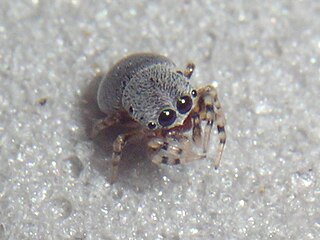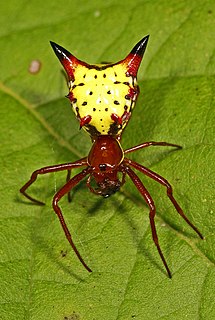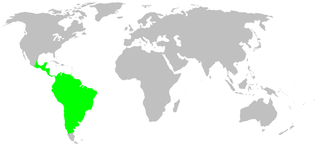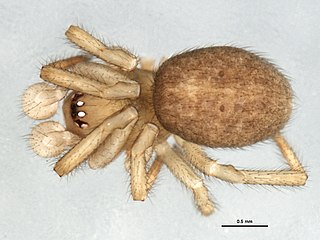
The Thomisidae are a family of spiders, including about 175 genera and over 2,100 species. The common name crab spider is often linked to species in this family, but is also applied loosely to many other families of spiders. Many members of this family are also known as flower spiders or flower crab spiders.

Theridiidae, also known as the tangle-web spiders, cobweb spiders and comb-footed spiders, is a large family of araneomorph spiders first described by Carl Jakob Sundevall in 1833. This diverse, globally distributed family includes over 3,000 species in 124 genera, and is the most common arthropod found in human dwellings throughout the world.

Theridiosoma is a genus of ray spiders that was first described by Octavius Pickard-Cambridge in 1879.

Cylistella is a genus of jumping spiders that was first described by Eugène Louis Simon in 1901.

Huttonia is a monotypic genus of ecribellate South Pacific araneomorph spiders in the Huttoniidae family containing the single species, Huttonia palpimanoides. Although only one species is described, there are still about twenty more undescribed species.

Castianeira is a genus of ant-like corinnid sac spiders first described by Eugen von Keyserling in 1879. They are found in Eurasia, Africa, and the Americas, but are absent from Australia. Twenty-six species are native to North America, and at least twice as many are native to Mexico and Central America.

Micrathena, known as spiny orbweavers, is a genus of orb-weaver spiders first described by Carl Jakob Sundevall in 1833. Micrathena contains more than a hundred species, most of them Neotropical woodland-dwelling species. The name is derived from the Greek "micro", meaning "small", and the goddess Athena.

Sason is a genus of bark-dwelling brushed trapdoor spiders first described by Eugène Simon in 1887. It is distributed from the Seychelles through India to northern Australia. The closest related genus seems to be the monotypic Paracenobiopelma.
Stoliczka is a genus of Pakistani nursery web spiders that was first described by Octavius Pickard-Cambridge in 1885. As of June 2019 it contains only two species, found only in Pakistan: S. affinis and S. insignis.

Senoculus is a genus of araneomorph spiders in the family Senoculidae, and was first described by Władysław Taczanowski in 1872. It is the only genus in the family Senoculidae.

Anahita is a genus of wandering spiders first described by Ferdinand Karsch in 1879.

Agroeca is a genus of liocranid sac spiders that was first described by Niklas Westring in 1861.

Robertus is a genus of comb-footed spiders that was first described by Octavius Pickard-Cambridge in 1879. It is considered a senior synonym of Garritus.

Friula is a genus of orb-weaver spiders containing the single species, Friula wallacei. It was first described by O. Pickard-Cambridge in 1897, and has been found only on Borneo. Pickard-Cambridge based his description and drawing on a specimen collected by Alfred Russel Wallace in Sarawak between November 1854 and January 1856. Pickard-Cambridge personally confirmed with Wallace that Wallace "was the captor of this spider, and in the locality mentioned." In 2017, the Alfred Russel Wallace Memorial Fund published a call for observations of this species, stating that no specimens of the species have been collected since Wallace's and that his specimen, housed at Oxford University, is the only known specimen in the world.
Anisaspoides is a monotypic genus of Brazilian baldlegged spiders containing the single species, Anisaspoides gigantea. It was first described by Frederick Octavius Pickard-Cambridge in 1896, and is only found in Brazil.

Nilus is a genus of nursery web spiders that was first described by Octavius Pickard-Cambridge in 1876.

Phycosoma is a genus of comb-footed spiders that was first described by Octavius Pickard-Cambridge in 1880.
Collinsia is a genus of dwarf spiders that was first described by Octavius Pickard-Cambridge in 1913.

Gasteracantha clavatrix is a species of spider of the genus Gasteracantha. It occurs in Indonesia.















